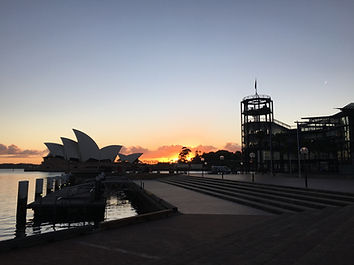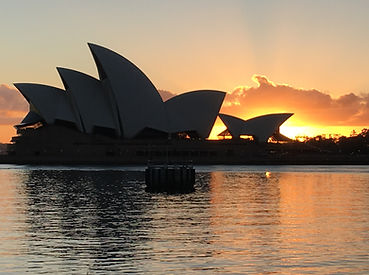Teacher and Writer
ASTRID SEELE

THE SYDNEY OPERA HOUSE
4 November 2016
SYDNEY OPERA HOUSE
On architectural vision, political intrigue and early morning peace
Last night I saw the fantastic opera “The Eighth Wonder”, the operatic history of the Sydney Opera House, performed outside on its monumental steps, against the perfect backdrop of the building itself. It was a rather spectacular experience, and I enjoyed every minute as the drama unfolded. It was a beautiful night, and the performance started just as the sun set behind the Harbour Bridge. The sliding stages were a stroke of genius, and the talents of the orchestra and the chorus (who performed inside) and the skills of the soloists (who performed on the steps) were enhanced through the experience of listening to the often dramatic and sometimes comedic music and dialogue through headphones. The acoustic quality was rather astounding, and almost all background noise was cancelled, making this a very intimate listening experience.
Although undoubtedly the writers have taken the liberty to add some fictional detail to their version of the history of Sydney’s famous venue, the true story that forms its backbone is so dramatic that it hardly needs any embellishment. This is very much the story of one man’s vision and mission, the obstacles he encounters, the political agendas he is caught up in, the prejudice he fights against and the intrigue and backstabbing he ultimately falls victim to. In a poignant scene towards the end, "The Politician" (personifying either the NSW premier Robert Askin, a critic of the Opera House, or his self-serving Minister for Public Works, David Hughes), who has had enough of the architect’s big ego, his rising demands and costly and time-consuming perfectionism, asks his government engineer whether the building could be completed without Utzon. After a feeble protest and under the pretence of loyalty (“It is his building”) the engineer does what is expected of him and obediently concedes that it could. The politician asks him whether he would stay on if he were to let Utzon go, and the engineer dutifully complies, thus paving the way for the new NSW government to provoke Utzon to resign. The Australian architecture critic Elizabeth Farrelly called this outrageous outcome "the triumph of homegrown mediocrity over foreign genius." The building was completed without the brilliant architect who designed it, and his name was not mentioned at the opening ceremony.
Such backstage plotting makes the story of the Opera House not only into an account of the history of an iconic building and the vision of its architect, but also into a perennial tale and parable of human betrayal and politics. The optimistic message of this story though is one of triumph of vision and professional standards over petty bureaucracy and political intrigue. Jørn Utzon’s name has become immortal, and Sydney has tried to make it up to him ever since. The names of those who turned their backs on him, for political gain or to further their own career, have been forgotten.
I not only enjoyed the performance itself, but also the conversations with two lovely families I started talking to in the interval: an Australian family of four who were incredibly proud of their national heritage (the parents had seen the original staging of this opera twenty years ago inside the Opera House before their sons were born and now wanted to share the experience with them), and a Danish family of five, currently on a business holiday to Sydney, who found it rather special to be present for this celebration of their fellow countryman’s contribution to Australia’s heritage.
For me, yesterday did not just end with the Opera House, it had actually started with it. I had got up very early to go for a little morning stroll on the Rocks, and I was lucky enough to catch some lovely glimpses of the rising sun. An early morning walk is indeed, as Henry David Thoreau once remarked, “a blessing for the whole day.” The sunrise symbolises new beginnings, its warm glow gives you fresh hope for the day and its sheer beauty is calming and puts earthly strives into perspective. In the words of Lord Byron’s Fourth Canto from Childe Harold’s Pilgrimage:
There is a pleasure in the pathless woods,
There is a rapture on the lonely shore,
There is society, where none intrudes,
By the deep sea, and music in its roar:
I love not man the less, but Nature more,
From these our interviews, in which I steal
From all I may be, or have been before,
To mingle with the Universe, and feel
What I can ne’er express, yet cannot all conceal.
As I was strolling along, I marvelled not only at the beauty of the sun rising behind the Opera House and gradually climbing above it, but also on the changing views I enjoyed. I have tried to capture some of them in my photographs. The peaceful atmosphere, the gentle harbour noises at that early hour and the calming views formed a counterpoint to the story of drama and politics I was to watch in the evening. I also read the changing views as a metaphor for different perspectives, and as a reminder how important it is to look at complex situations in a three-dimensional rather than two-dimensional way, considering them from different angles and viewpoints and putting oneself into the skin of others before judging them exclusively from one’s own perspective.














